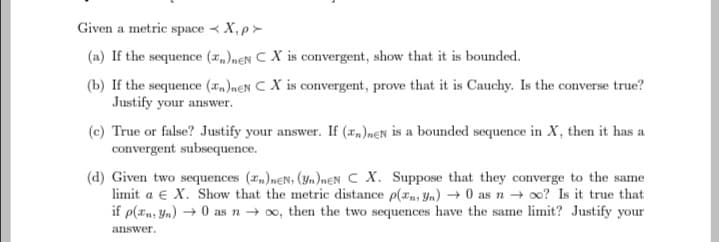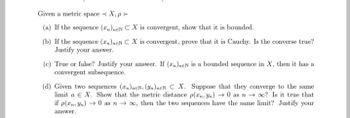(a) If the sequence ()neN CX is convergent, show that it is bounded. (b) If the sequence (n)neN CX is convergent, prove that it is Cauchy. Is the converse true?
(a) If the sequence ()neN CX is convergent, show that it is bounded. (b) If the sequence (n)neN CX is convergent, prove that it is Cauchy. Is the converse true?
Algebra & Trigonometry with Analytic Geometry
13th Edition
ISBN:9781133382119
Author:Swokowski
Publisher:Swokowski
Chapter10: Sequences, Series, And Probability
Section10.2: Arithmetic Sequences
Problem 68E
Related questions
Question

Transcribed Image Text:Given a metric space.
<X,p>
(a) If the sequence (n)neN CX is convergent, show that it is bounded.
(b) If the sequence (Tn)neN C X is convergent, prove that it is Cauchy. Is the converse true?
Justify your answer.
(c) True or false? Justify your answer. If (n)neN is a bounded sequence in X, then it has a
convergent subsequence.
(d) Given two sequences (zn)neN, (n)nEN C X. Suppose that they converge to the same
limit a € X. Show that the metric distance p(x, yn) → 0 as noo? Is it true that
if p(xn, Yn) → 0 as noo, then the two sequences have the same limit? Justify your
answer.
Expert Solution
This question has been solved!
Explore an expertly crafted, step-by-step solution for a thorough understanding of key concepts.
Step by step
Solved in 2 steps with 1 images

Follow-up Questions
Read through expert solutions to related follow-up questions below.
Follow-up Question
Can I please have question c and d in this question
Solution
Follow-up Question
Assistance with c and d

Transcribed Image Text:Given a metric space.
<X,p>
(a) If the sequence (n)neN CX is convergent, show that it is bounded.
(b) If the sequence (Tn)neN C X is convergent, prove that it is Cauchy. Is the converse true?
Justify your answer.
(c) True or false? Justify your answer. If (n)neN is a bounded sequence in X, then it has a
convergent subsequence.
(d) Given two sequences (zn)neN, (n)nEN C X. Suppose that they converge to the same
limit a € X. Show that the metric distance p(x, yn) → 0 as noo? Is it true that
if p(xn, Yn) → 0 as noo, then the two sequences have the same limit? Justify your
answer.
Solution
Recommended textbooks for you

Algebra & Trigonometry with Analytic Geometry
Algebra
ISBN:
9781133382119
Author:
Swokowski
Publisher:
Cengage


Algebra & Trigonometry with Analytic Geometry
Algebra
ISBN:
9781133382119
Author:
Swokowski
Publisher:
Cengage
